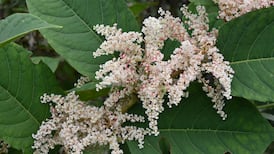When is the best time to move delphiniums? I have a magnificent clump, growing in a sunny border for many years, which is the envy of everyone who sees it. I’d like to lift and divide it, but don’t want to lose it by doing it at the wrong time of year.
Alice H, Co Carlow
This stately, hugely decorative herbaceous perennial is a classic back-of-border plant with impressively tall flower spires in various shades of blue as well as lilac, white and pink (depending on the variety) that appear in early summer and then again in early autumn in a smaller, second flush. Not easy to grow well, delphiniums love a deep, rich, moist but free-draining soil and a warm, sheltered spot in full sun with protection from strong winds as well as slugs and snails. Long-lived when happy, plants can form extensive, dense, clumping root systems over time and should ideally be divided every three to four years.
Traditionally, this should be done in early spring, just before the plant emerges from winter dormancy and enters active growth. But it’s also possible to do so from late September to November, when the plant has become winter-dormant and any leafy growth has died back down to ground level. Both have their advantages and disadvantages.
RM Block
Lifting, dividing and replanting at this time of year ensures the newly divided root segments have a good chance of establishing themselves into warm, moist ground before winter hits. But in cold, wet gardens, there’s a risk that they may rot in the ground before doing so. Alternatively, doing this in spring avoids the risk of the latter, but instead runs the risk of the recently divided root segments not having sufficient time to re-establish viable root systems before the ground starts to dry out. Unfortunately, the latter seems to be happening increasingly early and more often in recent years due to climate change, as seen this spring when near-drought conditions prevailed in March to April.
So, on balance, unless you don’t mind the chore of regularly watering the transplanted divisions during any dry spells, I’d recommend dividing and transplanting your delphinium now. Use a sharp spade, cleanly cutting the root ball into several individual segments, each at least as big as your clenched fist, discarding the woody centre of the clump. As an added safeguard, you could always pot on one of the divisions and place this in a bright, sheltered spot over winter. That way, even if the very worst happens and the other divisions fail to take (which is unlikely), you won’t have lost your much-loved plant.
















